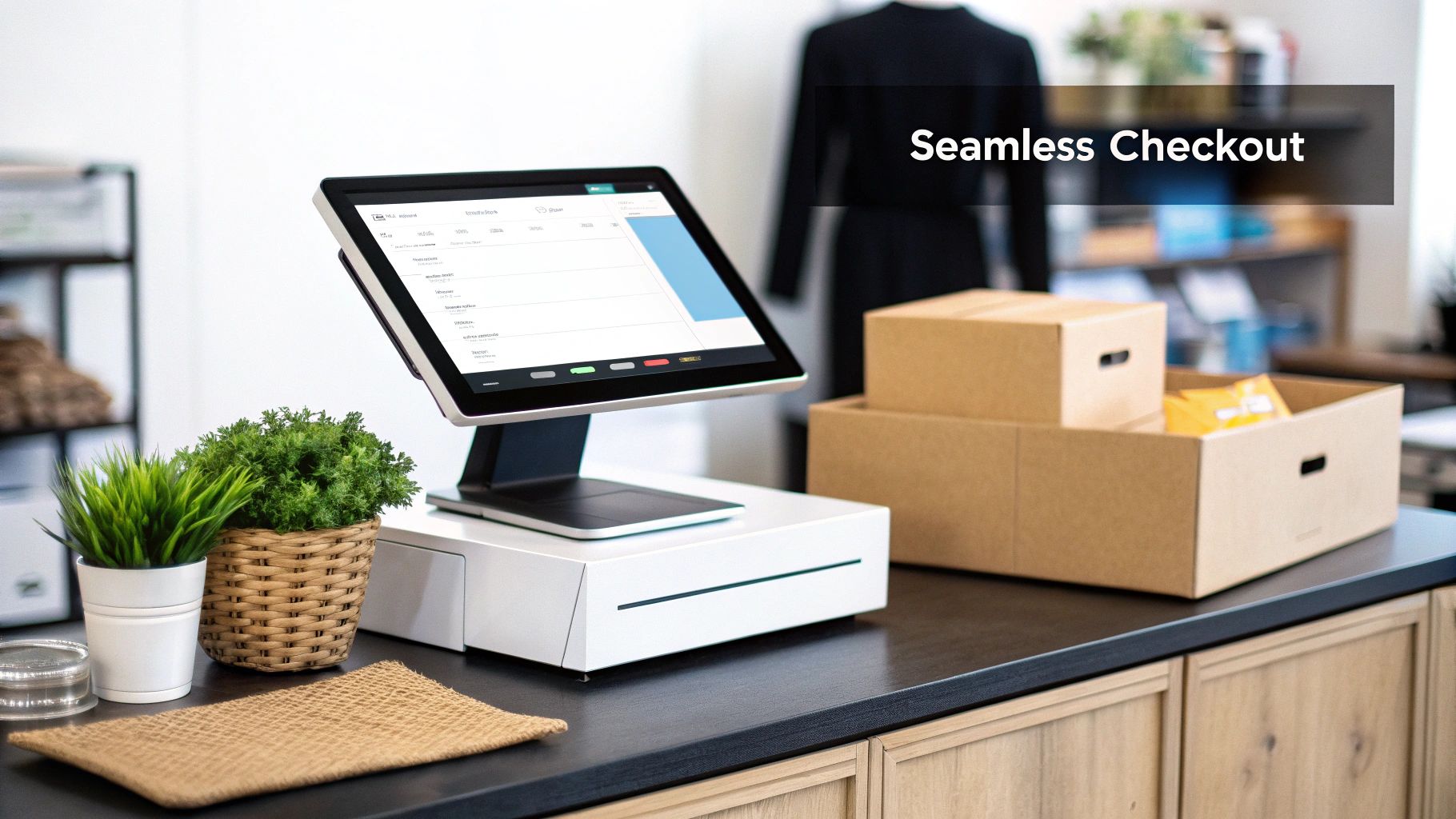Improve eCommerce Sales: Proven Tactics & Tools (2025)
March 30, 2025

Navigating the Modern Ecommerce Landscape

The ecommerce world is dynamic and constantly evolving. Understanding this landscape is key to improving ecommerce sales. Consumer behavior, technological advancements, and global market trends all influence how businesses operate online. This section explores these key areas to help you develop winning strategies.
Understanding the Global Market
Thriving in ecommerce starts with recognizing its massive scale. The global ecommerce market has grown tremendously, creating opportunities for businesses of all sizes. In 2024, global ecommerce sales topped $6 trillion. Projections suggest this figure will hit $8.09 trillion by 2028.
This represents a substantial 57.7% increase from 2022’s $5.13 trillion. China and the United States lead in sales, exceeding a combined $2.32 trillion in 2023. A robust online presence is essential for businesses looking to capitalize on this expansion. Learn more about global ecommerce sales.
The Rise of Mobile and Social Commerce
Mobile devices and social media have changed how consumers shop. Mobile commerce has become incredibly influential, allowing people to shop from anywhere. Businesses need to optimize their websites for mobile to ensure a smooth shopping experience.
Social commerce, or selling through social media platforms like Instagram and TikTok, is also gaining momentum. Businesses must adapt their strategies to connect with customers on these platforms.
Regional Nuances and Sector Growth
The ecommerce landscape isn't the same everywhere. Regional differences in consumer preferences, internet access, and regulations require specific approaches. What works in one area may not work in another. Understanding your target market is crucial for success.
Specific sectors within ecommerce are also seeing rapid growth. This creates both opportunities and challenges. Identifying these high-growth sectors can help businesses focus their resources where they’ll have the most impact. Staying informed and adapting to trends will help businesses navigate the complexities of ecommerce and achieve lasting success.
Capitalizing on Shifting Consumer Behaviors

Ecommerce success isn't about chasing the latest fads. It's about understanding the motivations behind consumer choices. This understanding is the key to boosting ecommerce sales. It requires careful attention to the changing expectations that influence how people shop online.
The Impact of Disruptions
Significant events, like the COVID-19 pandemic, have drastically reshaped the retail world. Improving ecommerce sales often means tapping into consumer behavior trends. For instance, the pandemic sped up the shift to online shopping by approximately five years.
As a result, ecommerce now accounts for 21.2% of total retail sales, with mobile and social commerce taking center stage. In 2024, there were 2.71 billion online shoppers, a remarkable 33% of the global population. By incorporating mobile and social platforms into their strategies, companies can substantially improve their targeting and engagement, ultimately driving sales higher. For more detailed statistics, check out this resource: https://www.yaguara.co/global-ecommerce-sales-growth/
This rapid change has significantly affected customer loyalty. Consumers are less attached to particular brands and more willing to try new things. This creates both obstacles and advantages for businesses.
Understanding the New Customer Journey
The modern customer journey is more intricate than ever before. It frequently involves many touchpoints across different devices and platforms. Businesses need to provide consistent experiences that cater to these varied interactions.
For example, a shopper might first see a product on social media, then research it on their phone, and ultimately buy it on their computer.
Identifying Micro-Trends and Gathering Insights
To keep pace with these changes, companies must look beyond general market trends and pinpoint micro-trends within their specific niche. This means ethically gathering and examining customer data to understand their changing needs and preferences.
Techniques like customer surveys, feedback forms, and social listening are extremely helpful in gathering this valuable information. For Shopify users, here's a relevant resource: How to Increase Sales on Shopify.
Adapting to Mobile and Social Commerce
The growth of mobile and social commerce has opened new channels for connecting with customers. Companies must optimize their online presence for these platforms, offering mobile-friendly websites and compelling social media content. This involves developing simple checkout processes for mobile and using social media for both marketing and customer support.
However, simply having a presence on these platforms isn't sufficient. Businesses also need to cultivate authentic connections with their audience. Building trust and creating a sense of community are vital for sustained success in these evolving spaces.
To understand how consumer behavior has changed, let's look at a comparison of pre- and post-pandemic shopping habits. The following table highlights key shifts and their implications for sales strategies.
Pre vs. Post-Pandemic Ecommerce Behaviors: A comparison of key consumer shopping behaviors before and after the pandemic's impact on ecommerce
| Behavior | Pre-Pandemic | Post-Pandemic | Impact on Sales Strategy |
|---|---|---|---|
| Channel Preference | Primarily in-store, online for specific items | Increased online shopping across categories | Omnichannel approach crucial, focus on online experience |
| Brand Loyalty | High loyalty to established brands | Reduced brand loyalty, increased openness to new brands | Focus on customer acquisition, personalized offers, and building trust |
| Delivery Expectations | Standard shipping times acceptable | Faster shipping and flexible delivery options expected | Offer expedited shipping, free shipping thresholds, and click-and-collect |
| Digital Engagement | Less reliance on mobile and social commerce | Increased use of mobile and social media for shopping | Mobile-first approach, social media marketing and engagement crucial |
| Customer Service | Primarily in-store or via phone/email | Demand for instant online customer support | Implement live chat, chatbots, and social media customer service |
Key takeaways from this table include the decreased brand loyalty post-pandemic, necessitating a stronger focus on customer acquisition, and the increased importance of a mobile-first strategy due to the rise in mobile commerce. Adapting to these changes is vital for ecommerce success.
Crafting Product Pages That Convert

Product pages are essential for any e-commerce store. They're where customers make their purchasing decisions. This section explores how to create product pages that truly convert, leading to more sales. We'll look at the key factors that influence those decisions, including engaging descriptions and using social proof.
The Psychology of Persuasion
Effective product pages understand buyer psychology. They anticipate customer concerns and build trust. High-quality images, for instance, showing the product from various angles, give customers a better idea of what they’re buying. This reduces uncertainty and encourages purchases.
Detailed product descriptions go beyond just listing features; they highlight benefits. They answer the important question: "What's in it for me?" Explaining how a product solves a problem or improves a customer’s life is much more persuasive than simply listing specifications.
Optimizing Key Elements for Conversion
Several key elements contribute to a high-converting product page. When optimized, these elements significantly improve sales:
- Compelling Product Descriptions: Use persuasive language focusing on benefits and addressing potential concerns.
- High-Quality Images and Videos: Showcase the product in use, highlighting its features and applications.
- Clear Pricing and Shipping Information: Transparency builds trust and simplifies the checkout process.
- Authentic Social Proof: Customer reviews, testimonials, and social media activity boost credibility.
- Clear Call to Action: A prominent "Add to Cart" button makes it easy for customers to buy.
A/B Testing for Continuous Improvement
Creating a high-converting product page is an ongoing process. A/B testing is crucial for continuous optimization. This means creating two versions of a page with one element changed (like button color or call-to-action text) and monitoring which one performs better.
For example, test different product descriptions to find which one leads to more items added to carts. You might find How to master Shopify Conversion Optimization helpful. This iterative process allows data-driven refinements that maximize conversions and improve sales over time.
Creating a Seamless Customer Journey
A smooth customer journey is vital for conversions. This means minimizing obstacles at every step, from product discovery to checkout. For instance, a complex checkout process can lead to abandoned carts, undermining even the best product page.
Streamlining the checkout, offering multiple payment options, and clearly displaying shipping information are essential. By addressing these potential issues, businesses can increase sales and build customer loyalty. A positive experience leads to repeat business and positive word-of-mouth referrals.
Leveraging AI to Improve Ecommerce Sales

Optimizing product pages for conversions is essential for ecommerce success. Now, let's explore how artificial intelligence (AI) can boost those efforts and improve your overall sales. AI offers powerful tools to personalize the customer journey and streamline your business operations.
Personalized Product Recommendations
One of the most impactful uses of AI in ecommerce is personalized product recommendations. Think of it like having a salesperson in a physical store who knows exactly what you want before you even ask. AI can bring this experience online.
By analyzing customer data like browsing history and past purchases, AI algorithms can predict which products each shopper will likely be interested in. This personalized touch enhances the shopping experience and can significantly boost conversion rates.
For example, if a customer regularly buys running shoes, an AI-powered system might suggest related items like running apparel, fitness trackers, or hydration packs. This targeted approach, compared to generic suggestions, is much more effective and leads to a greater chance of a purchase.
AI-Powered Chatbots for Enhanced Customer Service
Excellent customer service is vital for improving ecommerce sales. AI-powered chatbots are changing how support is delivered by offering immediate help, 24/7.
These virtual assistants handle a wide range of questions, from product details to shipping issues. This frees up human agents to handle more complex situations. The improved availability and quick responses create a more positive customer experience, building loyalty and encouraging repeat business.
Chatbots are becoming increasingly common. 80% of retail and ecommerce businesses are currently using or plan to implement them. Furthermore, it's projected that AI will manage 80% of all customer interactions by 2030. Learn more about these trends and their impact on ecommerce in this article on ecommerce trends.
Automating Inventory Management with AI
Effective inventory management is key to smooth operations and profitability. AI can automate this process by analyzing sales data, predicting changes in demand, and optimizing stock levels.
This helps prevent both running out of popular items and having too much slow-moving stock. Having the right products available at the right time saves money and keeps customers happy.
Predictive Analytics for Data-Driven Decisions
AI-powered predictive analytics provides valuable insights into customer behavior and market trends. This information empowers businesses to make smart decisions about pricing, marketing campaigns, and developing new products.
By anticipating future trends, businesses can adjust their strategies proactively, staying ahead of the competition and maximizing their chances for success.
Creating a Multi-Channel Revenue Engine
Today's ecommerce success hinges on reaching customers wherever they shop. Each platform, from your website to social media, presents a valuable opportunity to connect and boost sales. This means building a multi-channel revenue engine—a system where every platform works together to maximize overall revenue.
Identifying Your Key Channels
Not all channels are created equal. Focus on the platforms your target audience uses most. This requires understanding your customer profiles. For example, if you sell visually appealing products, Instagram might be a good fit. Products with a strong community aspect could perform better on platforms like Facebook. Where your customers are is where you need to be.
Maintaining Brand Consistency Across Platforms
Each platform has its own style, but a consistent brand experience is essential. Use a unified brand voice, visual style, and messaging across all channels. Your logo, color scheme, and core message should be consistent, even if content formats vary. This builds customer trust and brand loyalty.
Optimizing for Platform-Specific Advantages
While consistency is key, tailor your strategies to each platform. This means adjusting content and promotions to resonate with the platform's audience and format. Use platform-specific features, like shoppable posts on Instagram or live streams on TikTok, to connect with customers in engaging ways.
To help illustrate the performance and challenges of different sales channels, let's look at the following table:
Ecommerce Channel Performance Comparison: This table compares different sales channels and their typical performance metrics.
| Sales Channel | Avg. Conversion Rate | Customer Acquisition Cost | Best Product Categories | Implementation Difficulty |
|---|---|---|---|---|
| Website | 2-3% | Varies widely | All | Medium |
| Email Marketing | 2-5% | Low | Niche products, repeat purchases | Easy |
| Social Media (Organic) | <1% | Low | Visually appealing products, impulse buys | Easy |
| Social Media (Paid) | 1-3% | Medium | Targeted demographics, specific interests | Medium |
| Marketplaces (e.g., Amazon, Etsy) | 10-15% | High | High-demand products, competitive pricing | Medium |
Key takeaway: While marketplaces offer high conversion rates, they come with higher costs. A balanced approach across multiple channels often yields the best results.
Cross-Channel Analytics and Attribution
Tracking customer journeys across multiple channels is crucial. Cross-channel analytics provides insights into how customers interact with your brand at different touchpoints. This data helps optimize your strategy by identifying which platforms drive the most valuable traffic and conversions. It's about understanding the entire customer journey, not just isolated sales per channel.
Streamlining Inventory and Content Across Channels
Managing inventory and content across various channels can be complex. Use systems for efficient inventory synchronization and streamlined content distribution. Tools like centralized inventory management systems and content scheduling tools are helpful. This ensures accurate stock information and prevents overselling. Repurposing content across channels also maximizes its reach.
Creating Seamless Customer Transitions
Guide customers toward purchase, no matter where they start. Create seamless transitions between channels. For example, a social media post could link directly to a product page. This smooths the customer journey, minimizes friction, and increases the likelihood of a sale. It creates a positive customer experience and strengthens your brand presence throughout the buying process.
Recapturing Lost Sales At Checkout
One of the most effective ways to boost your ecommerce sales is by tackling cart abandonment. With abandonment rates frequently topping 70%, recovering these potential sales is a key strategy for increasing revenue. Let's explore some proven tactics for winning back lost sales at different stages of the checkout journey.
Identifying Abandonment Triggers
Understanding why shoppers abandon their carts is the first step towards improving your conversion rates. Common reasons include:
- Unexpected Shipping Costs: High or unclear shipping costs are a major turn-off. A surprising 55% of shoppers abandon carts because of unexpected costs.
- Complex Checkout Procedures: A long or complicated checkout process can frustrate customers. Keep it simple and streamlined.
- Lack of Payment Options: Not offering preferred payment methods can result in lost sales. Provide a variety of choices, including credit cards, PayPal and other digital wallets like Apple Pay.
- Security Concerns: Customers need to feel secure about sharing their information. Display security badges and use a secure checkout process.
- Website Errors or Technical Issues: Glitches or slow loading times can disrupt the checkout flow.
Implementing Effective Cart Recovery Strategies
Addressing these issues with targeted solutions is essential for recovering lost sales and boosting your overall ecommerce performance. Consider these strategies:
- Optimizing Shipping Costs: Offer free shipping above a certain order value, be transparent about shipping fees, and offer various shipping options.
- Streamlining the Checkout Experience: Reduce the number of steps required, enable guest checkout, and offer pre-filled forms for returning customers.
- Expanding Payment Options: Include support for various credit cards and popular digital wallets.
- Reinforcing Security Measures: Clearly display trust badges such as Norton Secured and McAfee Secure, and ensure you're using a secure HTTPS connection.
- Addressing Technical Issues: Regularly test your website for errors, optimize loading times, and ensure your site is mobile-friendly.
Cart Recovery Messaging and Exit-Intent Technology
Strategic communication can help re-engage customers who have abandoned their carts. Key tactics include:
- Personalized Emails: Send automated emails that remind customers about abandoned items, offer incentives, and highlight product benefits.
- Exit-Intent Popups: Show targeted popups when customers are about to leave your site, offering a last-minute discount or other incentive.
For example, a small discount or free shipping offer in an exit-intent popup can often convince hesitant shoppers to complete their purchase. Use these tactics carefully, though, to avoid being intrusive.
Incentive Structures That Motivate Completion
Encouraging customers to finalize their purchase often involves providing compelling incentives:
- Discounts and Coupons: A small discount can be just what a customer needs to complete the purchase.
- Free Shipping: Free shipping is a strong incentive, especially for smaller purchases.
- Limited-Time Offers: Creating a sense of urgency can encourage immediate action.
While incentives can significantly improve ecommerce sales, use them strategically. Overuse can lead customers to expect discounts, reducing their impact.
Measuring Intervention Effectiveness
Track key metrics to evaluate the success of your cart recovery strategies:
- Cart Abandonment Rate: Monitor this rate to spot trends and measure the impact of your actions.
- Conversion Rate: See how many abandoned carts are recovered through your strategies.
- Revenue Recovered: Measure the actual dollar value generated from recovered sales.
Analyzing these metrics allows you to continually refine your approach and optimize your strategies for maximum recovery.
Ready to transform your Shopify store’s checkout and recover lost sales? LinkShop, a powerful link-in-bio app for Shopify merchants, offers beautiful, shoppable link-in-bio pages that integrate seamlessly with your cart recovery efforts. Check out LinkShop today to learn how it can improve your ecommerce sales.



